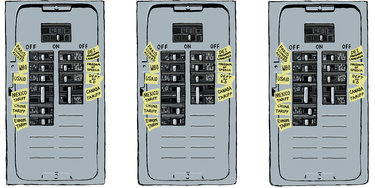From the editor: The three branches of our government are meant to provide checks and balances
On the second day of his administration, Jan. 21, President Donald Trump announced he would impose a 25 percent tariff on imports from Canada and Mexico.
That same day, Prime Minister Justin Trudeau spoke of his desire to uphold his country’s longstanding friendship with the United States, calling the trade relationship between the two nations “one of the most successful in the world.”
He stated some simple facts: Canadian energy powers manufacturing, businesses, and homes in the United States, and Canada buys more goods made by Americans than China, Japan, and Germany combined.
Trudeau also correctly noted that less than 1 percent of the illegal fentanyl coming into the United States comes from Canada and that the two nations were working collaboratively on a $1 billion comprehensive border plan.
Trudeau, who had announced in January that he would resign, concluded, “We stand at the ready to stand with the United States to create a booming and secure North American economy …. Canada is a safe, secure and reliable partner in an uncertain world.”
While Trump backed off his initial North American tariff proposal right away, on March 3, he issued an executive order saying he was proceeding with tariffs on Mexican and Canadian imports “to combat the extraordinary threat to U.S. national security, including our public health posed by unchecked drug trafficking.”
On March 4, our governor, Kathy Hochul, convened a roundtable in Albany because, she said, “I want to know the impacts of tariffs on our farmers and people across the state.”
We wrote about that roundtable and about an email address the state has established for businesses, including farms, to report the effects of these tariffs. Information provided to TariffImpact@esd.ny.gov “will help provide a real time understanding of the impact of the tariffs on the New York agricultural industry and other sectors across the state,” the governor’s office says.
On March 6, of course, as our updated story reports, Trump again postponed his threat, suspending tariffs on most imports from Mexico and Canada until April 2.
The whiplash caused a drag on the stock market. And Canada’s counter-tariffs are already in place.
As Trudeau explained at an Ottawa press conference, “So today the United States launched a trade war against Canada, their closest partner and ally, their closest friend. At the same time, they’re talking about working positively with Russia, appeasing Vladimir Putin, a lying, murderous dictator.
“Make that make sense.
“Canadians are reasonable and we are polite, but we will not back down from a fight — not when our country and the well-being of everyone in it is at stake. At the moment, the U.S. tariffs came into effect in the early hours of this morning, and so did the Canadian response.”
The Liberal Party’s Mark Carney, elected prime minister on Sunday, said he supports the retaliatory tariffs Canada has adopted.
On March 10, the day Ontario’s retaliatory 25-percent tariff on electricity went into effect, Hochul and Senator Charles Schumer wrote a letter to state agencies to “require that all New York utilities clearly communicate to consumers any increase in cost due to President Trump’s tariffs and Canadian retaliation.”
Hochul and Schumer also called on Trump to rescind the tariffs and went on, “If he refuses, Republicans in Congress must act to overturn them before they inflict further damage on working families and businesses.”
On March 10, Trump said he would impose an additional 25 percent tariff on steel and aluminum coming from Canada, responding to surcharges being imposed by Ontario on electricity.
“We don’t want this,” Trudeau had said in speaking directly to the American people of Trump’s tariff threats. “We want to work with you as a friend and ally, and we don’t want to see you hurt either. But your government has chosen to do this to you. As of this morning, markets are down and inflation is set to rise dramatically all across your country ….
“They’ve chosen to harm American national security, impeding access to the abundant critical minerals, energy, building materials, and fertilizers that we have and that the United States needs to grow and prosper.”
We don’t want this either.
We are pained not just because of rising costs but by what feels like an irrational betrayal.
Last summer, I was honored with an award by the International Society of Weekly Newspapers, presented at the annual convention, held in Toronto. A wonderfully diverse and incredibly vibrant city, Toronto made me feel welcome. I count the weekly Canadian editors as my friends.
I have been unable to explain to them or to myself why our nation is doing this.
I understand that tariffs, a tax on imports, have long been used by countries around the world. They can be useful to protect fledgling domestic industries or to pressure or hurt other nations.
While developing countries might have fragile industries to protect or might need revenues, wealthy countries generally have low tariffs.
The Council on Foreign Relations, a nonpartisan, nonprofit think tank with roots going back to a group of scholars who advised President Woodrow Wilson in peace talks after World War I, notes that the United States maintained high tariffs for decades, until income taxes supplanted tariffs as the most important source of revenue in the 1930s. After World War II, tariffs continued to decline as the United States emphasized trade expansion as a central plank of its global strategy.
Why would we, as a nation, want to harm an ally at great cost to our own citizens?
At last week’s roundtable, Governor Hochul correctly called Trump’s explanation for the tariffs — “to combat the extraordinary threat to U.S. national security, including our public health posed by unchecked drug trafficking” — a ruse.
“It’s a ruse,” Hochul said, “for finding an opportunity to really turn our relationships upside down with important countries that we rely on for partnership and markets for us. And if we lose them, they’re going to have retaliatory tariffs for us.”
This reminded me of the response I got from the Guilderland school superintendent, Marie Wiles, when I read her Trump’s Jan. 29 executive order, “Ending Radical Indoctrination in K-12 Schooling,” which alleges children are being indoctrinated “in radical, anti-American ideologies.”
Wiles described the language in Trump’s order as “gobbledegook.” “It does not reflect the reality of what happens in our classrooms,” said Wiles, noting faculty is guided by the state’s learning standards.
Reality matters.
The reality is that Russia invaded Ukraine, starting a war, not the other way around. The reality is that Trump lost the 2020 election despite his claims that have hoodwinked millions of Americans.
If students are not being indoctrinated in anti-American ideologies, why should public-school funds be cut?
If Canada is working with the United States, spending over a billion dollars, to curb the small amount of fentanyl coming over its long border, why should Canada be punished with tariffs?
And, in both cases, who will suffer from these orders?
Our students will suffer from cutting off federal funds for education. Most Americans will suffer from a trade war with Canada.
Hochul told the March 4 roundtable participants that she would use the information she gathered from the talk and also from TariffImpact@esd.ny.gov “to build the argument when I’m speaking to our legislators, our Republican members of Congress who are in the majority in Washington, when I go to the White House. I want to have the stories, the data, and be able to talk about the impact that these tariffs have had on the state of New York.”
So we urge our readers to write their own stories to the governor, and send a copy to members of Congress in the Republican majority.
We’d like to believe that we can still work together for the common good, but we are losing hope with each new assault.
Yes, of course, our federal government can be made more efficient. But construing public servants as “deep state” evil-doers and slashing programs willy-nilly is not the way to do it.
Yes, of course, our education system can be improved. But threatening to abolish the federal education department and the protections it provides for our most vulnerable students is not the way to do it.
During a virtual press conference on March 6, the day Trump’s executive order to dismantle the Department of Education was expected but did not come, education leaders noted how Trump is following the Project 2025 plan, which says of the department, “For the sake of American children, Congress should shutter it and return control of education to the states.”
Many of the speakers noted that states would not be able to fill the gaping hole.
“What does that mean for a place like New York?” asked Governor Hochul, answering herself. “Five billion dollars in cuts. We're talking about billions of dollars lost in Pell Grants, money for kids with disabilities, programs that are helping our kids in rural areas, and mental health.”
She went on, “This is a message from all the governors: We’re not going to be able to backfill losses like this scale.”
Hochul also said, “What they're doing is saying our kids don’t matter. What’s more important is that we slash for the sake of slashing, and also be able to fund tax breaks for millionaires and billionaires.”
John King, who was education secretary under President Barack Obama and now is chancellor of the state university system, described the U.S. Department of Education as “a civil rights agency, the place that ensures that students with disabilities get the services they need, that English-learners get the help they need.”
King said that courts have been somewhat successful in delaying the onslaught, noting, “When Congress appropriates dollars, that’s law.”
But he also said, “Congress needs to step up.”
Indeed it does. Our Constitution sets out three branches of government to provide the security of checks and balances. Surely some of the Republican members of Congress can see that the best way to serve their constituents is to end a trade war with Canada and to keep federal funds flowing to students.
Both would serve the best interests of our nation as a whole.
— Melissa Hale-Spencer, editor

